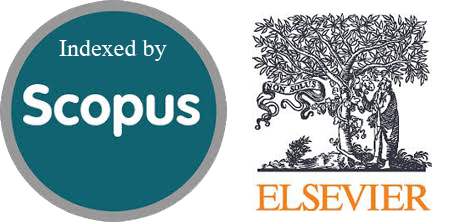MSER-Vertical Sobel for Vehicle Logo Detection
Abstract
Detecting a vehicle logo is the first step before realizing the identity of the logo. However, the detection of logos can pose difficulties due to various factors, including logo variations, differing scales and orientations, background interference, varying lighting conditions, and partial obstruction. This paper presents a vehicle logo detection method using hand-crafted features. We used a combination of Maximally Stable Extremal Region (MSER) and Vertical Sobel. We combine vertical Sobel with MSER to overcome MSER's limitation in recognizing objects of different sizes. These two features are merged using a closing morphology operation to form blobs selected as logo candidate areas. Moreover, a Support Vector Machine (SVM) is implemented to choose a logo area by analyzing each candidate's Histogram of Oriented Gradient (HOG). The proposed method was compared with other methods by implementing them on the same dataset. The significant advantage of using MSER-Vertical Sobel is its fast computation time. It is faster than other approaches that use non-handcrafted features. The test results show that the MSER-Vertical Sobel can achieve high accuracy and the fastest computation time.
Downloads
References
A. Psyllos, C. N. Anagnostopoulos, and E. Kayafas, “Vehicle model recognition from frontal view image measurements,” Comput Stand Interfaces, vol. 33, no. 2, pp. 142–151, 2011, doi: 10.1016/j.csi.2010.06.005.
H. Pan and B. Zhang, “An integrative approach to accurate vehicle logo detection,” Journal of Electrical and Computer Engineering, vol. 2013, 2013, doi: 10.1155/2013/391652.
J. W. Hsieh, L. C. Chen, and D. Y. Chen, “Symmetrical SURF and Its applications to vehicle detection and vehicle make and model recognition,” IEEE Transactions on Intelligent Transportation Systems, vol. 15, no. 1, pp. 6–20, 2014, doi: 10.1109/TITS.2013.2294646.
V. P. Le, “Logo Detection, Recognition and Spotting in Context by Matching Local Visual Features,” 2015. [Online]. Available: https://tel.archives-ouvertes.fr/tel-01373417
L. C. Chen, J. W. Hsieh, Y. Yan, and D. Y. Chen, “Vehicle make and model recognition using sparse representation and symmetrical SURFs,” Pattern Recognit, vol. 48, no. 6, pp. 1979–1998, 2015, doi: 10.1016/j.patcog.2014.12.018.
S. C. Huang, A. Pareek, S. Seyyedi, I. Banerjee, and M. P. Lungren, “Fusion of medical imaging and electronic health records using deep learning: a systematic review and implementation guidelines,” NPJ Digit Med, vol. 3, no. 1, 2020, doi: 10.1038/s41746-020-00341-z.
A. Sanaat, H. Arabi, I. Mainta, V. Garibotto, and H. Zaidi, “Projection Space Implementation of Deep Learning-Guided Low-Dose Brain PET Imaging Improves Performance over Implementation in Image Space,” J Nucl Med, vol. 61, no. 9, pp. 1388–1396, 2020, doi: 10.2967/jnumed.119.239327.
F. Zhang et al., “A Single Model Deep Learning Approach for Alzheimer’s Disease Diagnosis,” Neuroscience, vol. 491, pp. 200–214, May 2022, doi: 10.1016/j.neuroscience.2022.03.026.
A. Priyatama, Z. Sari, and Y. Azhar, “Deep Learning Implementation using Convolutional Neural Network for Alzheimer’s Classification,” Jurnal RESTI (Rekayasa Sistem dan Teknologi Informasi), vol. 7, no. 2, pp. 310–217, Mar. 2023, doi: 10.29207/resti.v7i2.4707.
R. I. Hasan, S. M. Yusuf, and L. Alzubaidi, “Review of the state of the art of deep learning for plant diseases: A broad analysis and discussion,” Plants, vol. 9, no. 10, pp. 1–25, 2020, doi: 10.3390/plants9101302.
A. Ahmad, D. Saraswat, and A. El Gamal, “A survey on using deep learning techniques for plant disease diagnosis and recommendations for the development of appropriate tools,” Smart Agricultural Technology, vol. 3, p. 100083, Feb. 2023, doi: 10.1016/j.atech.2022.100083.
D. O. Pribadi et al., “Mapping smallholder plantation as a key to sustainable oil palm: A deep learning approach to high-resolution satellite imagery,” Applied Geography, vol. 153, p. 102921, Apr. 2023, doi: 10.1016/j.apgeog.2023.102921.
F. Pérez-Hernández, S. Tabik, A. Lamas, R. Olmos, H. Fujita, and F. Herrera, “Object Detection Binary Classifiers methodology based on deep learning to identify small objects handled similarly: Application in video surveillance,” Knowl Based Syst, vol. 194, p. 105590, 2020, doi: 10.1016/j.knosys.2020.105590.
C. Jyotsna and J. Amudha, “Detection from Surveillance Video,” ICIMIA 2020 IEEE International Conference on Innovative Mechanisms for Industry Applications, no. Icimia, pp. 335–339, 2020.
P. Khaire and P. Kumar, “A semi-supervised deep learning-based video anomaly detection framework using RGB-D for surveillance of real-world critical environments,” Forensic Science International: Digital Investigation, vol. 40, Mar. 2022, doi: 10.1016/j.fsidi.2022.301346.
A. Berroukham, K. Housni, M. Lahraichi, and I. Boulfrifi, “Deep learning-based methods for anomaly detection in video surveillance: a review,” Bulletin of Electrical Engineering and Informatics, vol. 12, no. 1, pp. 314–327, Feb. 2023, doi: 10.11591/eei.v12i1.3944.
S. Angadi, “Hybrid Deep Network Scheme for Emotion Recognition in Speech,” International Journal of Intelligent Engineering and Systems, vol. 12, no. 3, pp. 59–67, 2019, doi: 10.22266/ijies2019.0630.07.
F. Zhang, Z. Li, B. Zhang, H. Du, B. Wang, and X. Zhang, “Multi-modal deep learning model for auxiliary diagnosis of Alzheimer’s disease,” Neurocomputing, vol. 361, pp. 185–195, Oct. 2019, doi: 10.1016/j.neucom.2019.04.093.
M. Jyotiyana, N. Kesswani, and M. Kumar, “A deep learning approach for classification and diagnosis of Parkinson’s disease,” Soft Comput, vol. 26, no. 18, pp. 9155–9165, Sep. 2022, doi: 10.1007/s00500-022-07275-6.
F. Rong, L. Shasha, X. Qingzheng, and L. Kun, “Object detection method on station logo with single shot multi‐box detector,” The Journal of Engineering, vol. 2020, no. 13, pp. 607–614, 2020, doi: 10.1049/joe.2019.1213.
J. Matas, O. Chum, M. Urban, and T. Pajdla, “Robust wide-baseline stereo from maximally stable extremal regions,” in Image and Vision Computing, 2004, pp. 761–767. doi: 10.1016/j.imavis.2004.02.006.
A. Śluzek, “Śluzek - 2016 - Improving performances of MSER features in matching and retrieval tasks.pdf,” in European Conference on Computer Vision, Springer, 2016, pp. 759–770.
G. Kosala, A. Harjoko, and S. Hartati, “Robust license plate detection in complex scene using MSER-Dominant Vertical Sobel,” IAENG Int J Comput Sci, vol. 47, no. 2, pp. 214–222, 2020.
S. M. Pizer et al., “Adaptive Histogram Equalization and Its Variations.,” Comput Vis Graph Image Process, 1987, doi: 10.1016/S0734-189X(87)80186-X.
G. Tong, M. Dong, X. Sun, and Y. Song, “Natural scene text detection and recognition based on saturation-incorporated multi-channel MSER,” Knowl Based Syst, vol. 250, p. 109040, Aug. 2022, doi: 10.1016/j.knosys.2022.109040.
Copyright (c) 2023 Jurnal RESTI (Rekayasa Sistem dan Teknologi Informasi)

This work is licensed under a Creative Commons Attribution 4.0 International License.
Copyright in each article belongs to the author
- The author acknowledges that the RESTI Journal (System Engineering and Information Technology) is the first publisher to publish with a license Creative Commons Attribution 4.0 International License.
- Authors can enter writing separately, arrange the non-exclusive distribution of manuscripts that have been published in this journal into other versions (eg sent to the author's institutional repository, publication in a book, etc.), by acknowledging that the manuscript has been published for the first time in the RESTI (Rekayasa Sistem dan Teknologi Informasi) journal ;








